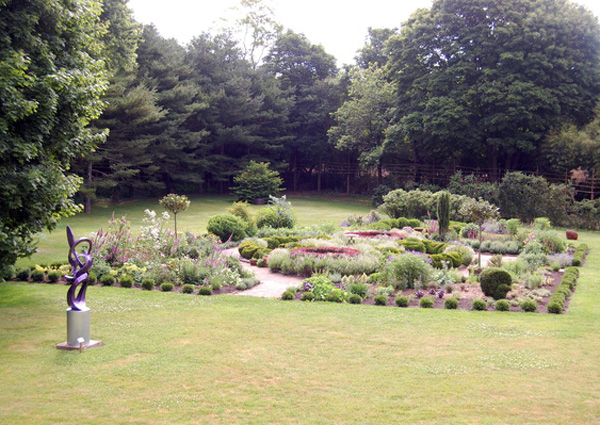
Pinning down the definition of Hamptons style could prove as difficult as conducting a door-to-door count of the people who make their homes here. But the experts agree that there is a common thread when it comes to that certain blend of East End elan and flair: people who live here are known the world over as arbiters of style because they have direct access to some of the best and most celebrated taste-makers in the world.
During a “Reflections on Hamptons Style” panel discussion last Thursday at St. Ann’s Parish in Bridgehampton, as part of the annual “St. Ann’s House Tour,” interior designer Marshall Watson led a cross-disciplinary group of his peers—all experts in their own rights—in talks about their experiences with Hamptons style. Panel participants included architect Preston T. Phillips, landscape architect Jack Delashmet, interior designer Eve Robinson and landscape and garden designer Victoria Fensterer, who shared their knowledge during the standing-room-only symposium.
“There is a certain refinement and cutting-edge design here,” Mr. Watson said as he introduced the concept of Hamptons style, adding that the East End has an abundance of the finest talent both living and working here. “As Madge from the commercials used to say, ‘you’re soaking in it.’”
Each of the experts on the panel told of a specific East End project that they had worked on. Mr. Phillips spoke of a house called “The Barnyard” in East Hampton; Mr. Delashmet discussed the European style gardens he created for a Bridgehampton client; Ms. Robinson spoke of her travails in converting a gloomy, Gothic Water Mill house into a light-filled home; and Ms. Fensterer talked about how she converted the famous ramshackle “Grey Gardens” into lush splendor.
For a recent project (and on the “St. Ann’s House Tour” two summers ago), Mr. Phillips was tasked with converting a kit barn into a modern Hamptons home. The primary directives given by his client were to create an urbane barn with a sunken living room and a see-through fireplace.
Mr. Phillips achieved “integrating the Hamptons vernacular” into his expansion on the single structure home by adding an additional barn structure and bridge span between the old and new barns. By integrating metal, steel and glass along the wooden planks and beams, he also updated the rustic home into a more contemporary showpiece.
At 4,200 square feet, the expanded house is small by mega-mansion standards but the open and airy floor plan and additions create a feeling of expansive, yet comfortable, space—the hallmarks of the Hamptons home.
“It looks like a small 1,800-square-foot house from the front facade, but you turn the corner and it’s exploding in all directions,” Mr. Phillips said.
Mr. Delashmet discussed how his experiences in transforming a Georgian home (on the “St. Ann’s House Tour” three years ago) into a European-feeling estate were indicative of the changes in the current Hamptons design climate.
“This job reflects the trends and significant changes we’ve had in the last five years due to the economy,” he said. “Everyone has become very value conscious, in all ways.”
Mr. Delashmet’s task was to transform a heavily sloped, environmentally sensitive property into a year-round blooming treasure—but in steps. He accomplished his plans by utilizing retaining walls to create high and low meadows, while saving as many trees as possible and using native plantings—such as daisies, mountain laurels and rhododendrons— extensively throughout the property.
Mr. Delashmet reported the project has been ongoing in stages for the last five years, according to a master plan he and his clients created together. He is now putting the final touches and “detailing” the gardens and the architecture.
Ms. Robinson talked about how she turned a “scary” house in Water Mill into her family home. She and her husband, a contractor, “updated an old house to more modern to achieve a timeless feeling.”
Inspired by the colors of nature, the designer painted over the dark interior walls and chose a palette consisting of blues, pinks, greens and browns to reflect the hues surrounding her East End home. Updating the house also included adding new floors from reclaimed materials, a stone fireplace and solar panels.
Ms. Robinson’s skill, which Mr. Watson described as “taking the modern idiom and making it warm,” shines through in the house, which is a mix of eras, styles and color.
“I like to create a space that people feel comfortable in, that has lastability, functionality, mixes the old and the new and meets the needs of Hamptons clients,” Ms. Robinson said. “They want a functional space where they can entertain and feel comfortable.”
Ms. Fensterer, the designer who conquered Grey Gardens in East Hampton, spoke of her experiences turning around a garden infamous for its neglect.
“It was so overgrown that there was nothing but a sea of vines ... And dirt, very precious dirt,” she said, adding that there were only two trees on the property when she was commissioned to work her magic on the ramshackle gardens, purchased from Edith “Big Edie” Ewing Bouvier Beale and her daughter, Edith “Little Edie” Bouvier Beale, by Ben Bradlee and Sally Quinn in 1979.
Citing inspiration from her favorite childhood book, “The Secret Garden,” Ms. Fensterer set about creating “a magical place with a year-round garden that would live up to its reputation.”
It would be a mistake to say that Ms. Fensterer restored Grey Gardens, as what she has done with dimension, depth, drama and scale far exceeds the original splendor. She did it by creating secret gardens—containing peegee hydrangea, a canopy of trees and lots of native plants and flowers—throughout the property.
“I wanted to create a feeling of protection there, to lighten up the heavy feeling,” Ms. Fensterer said. “A garden is a place to create magic in our lives.”